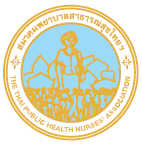Nursing practice for sepsis patients in the Medical Department, Chaopraya Abhaibhubejhr Hospital
Keywords:
Development, Nursing Practice, SepsisAbstract
Sepsis is an infectious condition that requires urgent assessment and appropriate nursing care to prevent septic shock and various complications. This study's objectives were to develop nursing care practices for sepsis patients in the Medical Department, Chaopraya Abhaibhubejhr Hospital, and examine their outcomes. The concept of participatory action was used to develop nursing practice guidelines for sepsis patients. A coaching technique was also applied to promote nursing practice. Subjects were 10 nurses in the coaching team, 65 nurses, and 366 sepsis patients. The study was divided into 4 phases; Phase 1: Situational Analysis, Phase 2: Development of nursing processes for sepsis patients, Phase 3: Promoting nursing practice, and Phase 4: Evaluation. The instruments used included nursing practice guidelines for sepsis patients and a coaching plan. Data were collected using a questionnaire assessing general characteristics, knowledge, an observation record form called ‘resuscitate: stop sepsis’, culture report, and hospital infectious surveillance form. Data were analyzed using descriptive statistics, paired t-test and chi-square.
Results show that nursing practice guideline for sepsis patients consists of various nursing activities including assessment and screening, nursing care in the 1st hour, the first 6 hours, 24-72 hours, and discharge plan. Outcomes of the development indicated that nurses had increased mean scores of knowledge and practice (p< 0.05). These improvements decreased re-shock and respiratory failure (p< 0.05). Development of nursing practice guidelines using participatory concepts led to nursing practice that was appropriate for this hospital’s context. Promoting practice through coaching can help increase knowledge and practice resulting in decreases in the severity of complications and mortality for sepsis patients.
References
Rudd KE, Johnson SC, Agesa KM, et al. Global, regional, and national sepsis incidence and mortality, 1990-2017: analysis for the Global Burden of Disease Study. The lancet 2020; 395: 200-11.
Perner A, Gordon AC, De Backer D, et al. Sepsis: frontiers in diagnosis, resuscitation and antibiotic therapy. Intensive Care Med 2016; 42: 1958-69.
Azkarate I, Choperena G, Salas E, et al. Epidemiology and prognostic factors in severe sepsis / septic shock. Evolution over six years. Med Intensive 2016; 40(1): 18–25.
Saengsanga P, Kiamkan N. Outcomes of Using the clinical Practice Guidelines for Patients 3 with Severe sepsis or Septic Shock care according to Sepsis Bundle Protocol at the ICU of Songkhla Hospital Thailand. Reg 11 Med Journal 2015; 29(3): 403-10. (in Thai)
Jitturongapoon K, Moolsawad M. Outcome of the treatment of a Patient with severe sepsis or septic shock move up to sub ICU on different time in Kamphaeng Phet Hospital. Kamphaeng Phet Hospital journal 2018; 22(2): 24-30. (in Thai)
Pinsai S, Permpool S. Outcome of community-acquired sepsis treatment and factors associated death after Prachinburi Sepsis guideline implementation: Prachinburi. Chaopraya Abhaibhubejhr Hospital; 2018.
Ramdacha K. Coaching and Mentoring. 3rd Bangkok: expernet co., Ltd; 2011.
Kumkoom I, Kasatpibal N, Chittteechour J. Effects of Coaching on Nurses' Knowledge and Practices Regarding Urinary Tract Infection Prevention in Older Persons in Long-term Care Facilities. Nursing journal 2017; 44(1): 1-10. (in Thai)
Kemmis S, McTaggart R. Action and Knowledge: Breaking the Monopoly with Participatory Action-Research. New York: Apex; 1991.
Bamrasnaradura infections Diseases Institute. Hospital Infection Diagnosis Book. 1st Bangkok: AKSORN GRPHIC AND DESIGN; 2018.
Howharn C, Inthongparn O. A Research and Development of Coaching Model to Enhance Health Care Service Skills. Nursing Journal of the Ministry of Public Health 2015; 25(1): 167-77. (in Thai)
DiPersia E, Colopinto K. Coaching the Change: 2% Chlorhexidine gluconate (CHG) And 70% Isopropyl Alcohol. American Journal of Infection Control 2010; 38(5): e94.
Juntachum W, Dapha S, Sritragool R, Wongsudta R, Kuttasing S, Krasae S. et al. The Development of Coaching Model of Nursing Practices among Nurse Preceptors, Bangkok Hospital Khon Kaen. Journal of Nursing and Health Care 2020; 38(1): 157-66. (in Thai)
Jamroenwong N, Piyarak S, Chaiwong C. Assessment and Nursing Care of a Patient with Septic Shock. The Southern college Network Journal of Nursing and Public Health 2020; 7(1): 319-30. (in Thai)
Intachub S, Posri D, Suwannasri J. Outcomes of using the MEWS (SOS Score) that affected the severe sepsis and septic shock in sepsis patients at Medical Department, Udonthani hospital. Udonthani Hospital Medical Journal 2017; 25(1): 85-92. (in Thai)
Teles F, Rodrigues WG, Alves MGT, Albuquerque CFT, Bastos SMO, Mota MFA, et al. Impact of a sepsis bundle in ward of a tertiary hospital. Journal of Intensive Care 2017; 5(45): DOI 10.1186/s40560-017-0231-2.
Sweeney DA, Kalil AC. Secondary Infection in Patients with Sepsis. The Journal of The American Medical Association 2016; 316(7): 771-72.
Downloads
Published
How to Cite
Issue
Section
License
บทความที่ตีพิมพ์และแผนภูมิรูปภาพถือเป็นลิขสิทธิ์ของวารสารพยาบาลสาธารณสุข (Thai Public Health Nurses Association)






